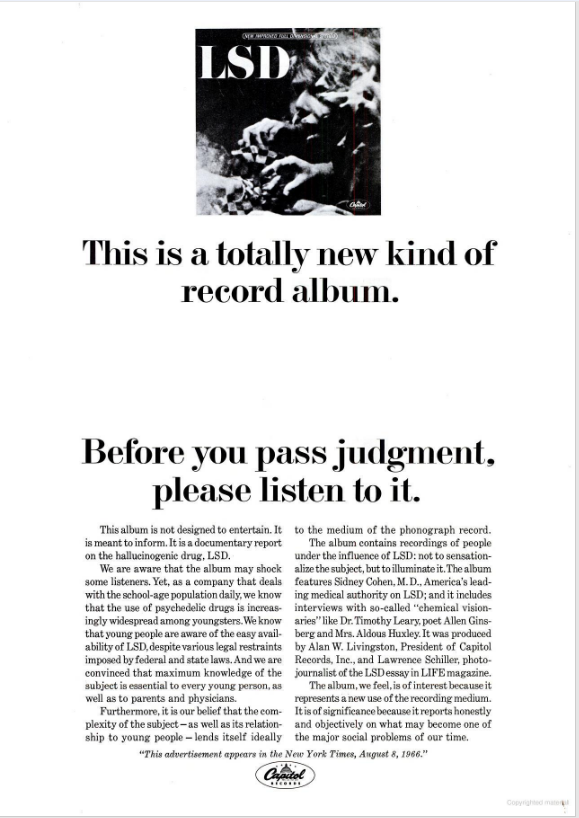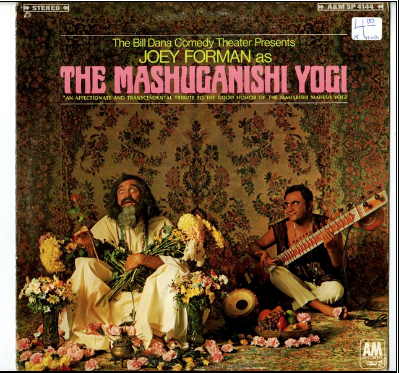1960s
LSD: The Vinyl Album Version
Discogs entry here.
Posted By: Paul - Wed Apr 08, 2020 -
Comments (1)
Category: Drugs, Psychedelic, PSA’s, 1960s
Three-Faced Doll
Introduced in 1961, her name was "Hedda-Get-Bedda." Twisting a knob changed her face from sick, to well, to sleepy.I'm surprised no one ever came out with a similar, Exorcist-themed doll. She could have been happy, sleeping, or demonically possessed.

Allentown Morning Call - Sep 29, 1961
Posted By: Alex - Sat Apr 04, 2020 -
Comments (2)
Category: Toys, 1960s
The Mashuganishi Yogi

Use embedded player, or go to the source.
Posted By: Paul - Sat Apr 04, 2020 -
Comments (5)
Category: Humor, Parody, Satire, Stereotypes and Cliches, 1960s, India
Follies of the Madmen #471
Posted By: Paul - Fri Apr 03, 2020 -
Comments (4)
Category: Addictions, Business, Advertising, Innuendo, Double Entendres, Symbolism, Nudge-Nudge-Wink-Wink and Subliminal Messages, Tobacco and Smoking, 1960s
Let’s try to stop smoking!!!!!!
Capitol Records released this album in 1964, on the heels of the Surgeon General's report detailing the harmful effects of smoking. Apparently that report inspired a fad for anti-smoking records. (See our earlier post about the 1964 album Music To Help You Stop Smoking).The Capitol Records release claimed to help listeners kick the smoking habit by hypnotizing them. The hypnotist was said to be a doctor, but for reasons of professional ethics he didn't reveal his identity, instead using the pseudonym Scott Gordon.
Discogs.com notes, "The title has one exclamation point on the back of the jacket and spine, no exclamation point on the label, and 6 on the front of the jacket."

Although I couldn't find any audio clips from the record online, I did come across this video posted by a British dance company in which they perform to a brief excerpt of Scott Gordon hypnotizing listeners.
Posted By: Alex - Tue Mar 31, 2020 -
Comments (2)
Category: Smoking and Tobacco, 1960s
Can fear cure cancer?
In 1962, East German researchers conducted a bizarre medical experiment in an attempt to find out if fear could cure cancer. They inoculated some "mice, rabbits, rats, and cocks" with cancer cells. Then they put these animals into a cage which they lowered "into a zoo-like enclosure where 30 ravenous African polecats paced for food. The polecats would leap upon the little cage, shrieking and clawing at their hoped-for prey." This terror experience was repeated every two hours for several days.The result: the cancer cells grew more slowly in the terrorized animals.
Of course, this begs the question, what it is about fear that would fight cancer? Was it the elevated adrenalin levels? Or was there some other biochemical change that caused the effect?
Unfortunately, I can’t find any other details about this unusual experiment except for the brief news report below. I'm assuming there was never a human version of the experiment. Though one never knows, given some of the other stuff that researchers got up to behind the Iron Curtain.

The Paterson News - Nov 7, 1962
Posted By: Alex - Fri Mar 27, 2020 -
Comments (0)
Category: Medicine, Science, Experiments, 1960s
The Wonder Glove
It was a mitten lined with “uranium ore,” sold in the early twentieth century as a cure for arthritis. It was part of the fad for radioactive cure-alls.Source: Your Money and Your Life: An FDA Catalog of Fakes and Swindles in the Health Field — an FDA pamphlet published in 1963 that includes a variety of other quack medical devices.

Posted By: Alex - Fri Mar 20, 2020 -
Comments (2)
Category: Health, 1960s
Mary Had a Little Man
The first song's unexceptional, but second one scores high on the Weird Meter.
Posted By: Paul - Fri Mar 20, 2020 -
Comments (3)
Category: Music, Myths and Fairytales, 1960s, Men, Women
Money Tree
At the 1964 New York World’s Fair, American Express displayed a “money tree.” Its foliage consisted of a million dollars in currency and travelers' cheques from countries around the world.

source of images: worldsfaircommunity.org
You can buy a money tree bag on eBay for $95:

Posted By: Alex - Thu Mar 19, 2020 -
Comments (3)
Category: Money, 1960s
Music to help you stop smoking
An album released in 1964. The Phoenix New Times offers some info about it:
Wikipedia has some info about The Living Strings:
There was no actual orchestra known as the Living Strings. The orchestra for most of the recordings was made up of musicians from various British orchestras assembled for the purpose of making the records.
I couldn't find any tracks from "Music to help you stop smoking" on YouTube, but apparently you can listen to the entire album on Spotify, if you have access to that (which I don't).
Posted By: Alex - Tue Mar 17, 2020 -
Comments (3)
Category: Music, Smoking and Tobacco, 1960s

| Who We Are |
|---|
| Alex Boese Alex is the creator and curator of the Museum of Hoaxes. He's also the author of various weird, non-fiction, science-themed books such as Elephants on Acid and Psychedelic Apes. Paul Di Filippo Paul has been paid to put weird ideas into fictional form for over thirty years, in his career as a noted science fiction writer. He has recently begun blogging on many curious topics with three fellow writers at The Inferior 4+1. Contact Us |




